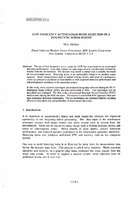| dc.contributor.author | Moebus, M. G. | |
| dc.date.accessioned | 2018-10-11T14:05:38Z | |
| dc.date.available | 2018-10-11T14:05:38Z | |
| dc.date.issued | 1993/08 | |
| dc.identifier | 796 | |
| dc.identifier.govdoc | CP-42/1 | |
| dc.identifier.uri | http://hdl.handle.net/20.500.12489/130 | |
| dc.description.abstract | The use of low frequency active sonar for ASW has repercussions on automated detection performance. Input data contain not only target returns, but also noise formed by returns from the environment The detector may report a contact that is actually the result of environmental noise. Detecting noise is an undesirable behavior in modern sonar systems. Noise characteristics such as bottom returns, tonals, and onset of convergence zones can produce a multitude of false alarms as well as poorer detection performance and reduced operator confidence in the automated system. In this study, noise rejection techniques are analyzed using data collected during the 92-3C Multistatic Sonar System (MSS) sea trials performed in 1992. Two techniques will be described and evaluated. The first is the conventional Bayesian Vector Classifier (BVC) method used during the MSS sea trials. The second is a modified BVC approach that uses post-sequential detection information. The two techniques are compared and the resulting effects on false alarm rate and probability of detection are discussed | |
| dc.format | 10 p. : ill., 3 fig. ; digital, PDF file | |
| dc.language | English | |
| dc.publisher | NATO. SACLANTCEN | |
| dc.source | In: Low frequency active sonar (SACLANTCEN Conference Proceedings CP-42), vol. 1, 1993, pp. C/10-1 - C/10-10. | |
| dc.subject | Low Frequency Active Sonar (LFAS) | |
| dc.subject | Multistatic sonar | |
| dc.subject | Target detection | |
| dc.subject | Noise reduction | |
| dc.subject | Signal processing | |
| dc.subject | Probability of detection (PD) | |
| dc.title | Low frequency active sonar noise rejection in a multistatic sonar system | |
| dc.type | Papers and Articles | |
| dc.type | Conference Proceedings (CP) | |
